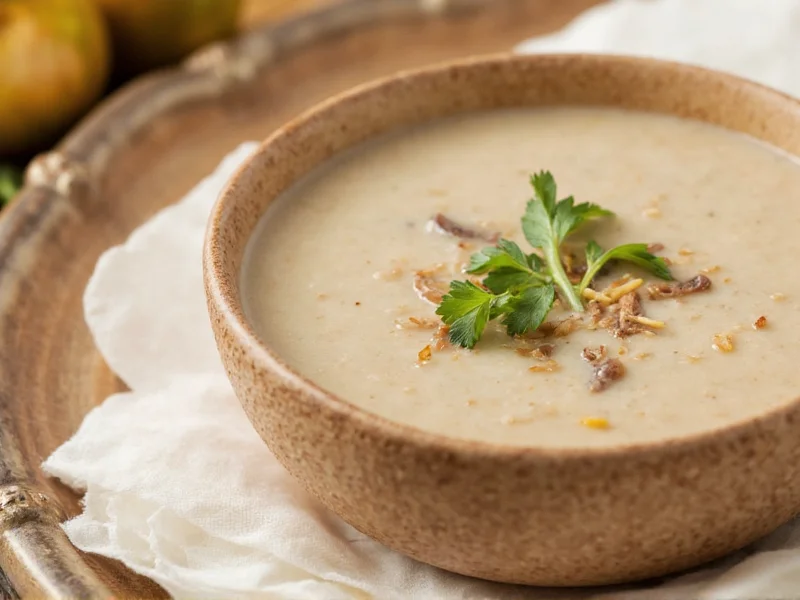Nothing compares to the deep, earthy flavor of homemade cream of mushroom soup. While canned versions have their place, crafting this classic from scratch transforms an ordinary pantry staple into a restaurant-quality dish that elevates casseroles, serves as a comforting standalone meal, or forms the base for sophisticated sauces. The secret lies in properly cooking the mushrooms to develop their natural umami before incorporating liquids.
The Science Behind Superior Mushroom Soup
Mushrooms contain significant water content that must evaporate before proper browning occurs—a process called the Maillard reaction. Rushing this step creates a watery, pale soup lacking depth. Professional chefs recommend cooking mushrooms in two batches to avoid overcrowding the pan, which lowers the temperature and causes steaming instead of searing.
Essential Ingredients Breakdown
Quality ingredients make the difference between good and exceptional soup. Here's what you need to know about each component:
| Ingredient | Why It Matters | Substitution Options |
|---|---|---|
| Crimini mushrooms | Deeper flavor than button mushrooms | Shiitake (for stronger taste), Portobello (use sparingly) |
| Unsalted butter | Rich base without overpowering salt | Olive oil (for dairy-free), ghee |
| Homemade broth | Superior flavor complexity | Low-sodium store-bought, vegetable broth (for vegetarian) |
| Heavy cream | Creates luxurious texture | Half-and-half (lighter), coconut cream (dairy-free) |
Step-by-Step Preparation Guide
Follow these precise steps for foolproof results every time:
- Prep mushrooms: Wipe 1 pound crimini mushrooms clean with a damp cloth (never soak), trim stems, and slice evenly.
- Sauté aromatics: Melt 3 tablespoons butter over medium heat. Add 1 diced onion and 2 minced garlic cloves, cooking until translucent (5 minutes).
- Cook mushrooms in batches: Add half the mushrooms with 1 teaspoon thyme. Cook without stirring for 4 minutes until browned, then stir and cook 5 more minutes. Repeat with remaining mushrooms.
- Build flavor foundation: Sprinkle 3 tablespoons flour over mushrooms, stirring constantly for 2 minutes to eliminate raw flour taste.
- Add liquids gradually: Slowly whisk in 4 cups broth, scraping browned bits from the pan bottom.
- Simmer and blend: Cook 15 minutes, then blend with 1 cup cream using an immersion blender until smooth.
- Final seasoning: Adjust salt, pepper, and additional thyme to taste. For extra richness, stir in 2 tablespoons cold butter off-heat.
Avoid These Common Mistakes
Even experienced cooks make these critical errors that compromise texture and flavor:
- Overcrowding the pan: Causes mushrooms to steam rather than brown—cook in batches
- Adding cold liquids to hot roux: Creates lumps—always temper with small amounts first
- Boiling after adding cream: Causes curdling—keep below simmering point
- Under-seasoning: Mushrooms require more salt than expected—season in layers
- Skipping the resting period: Flavors meld beautifully after 20 minutes off-heat
Delicious Variations for Every Occasion
Customize your cream of mushroom soup for different dietary needs and culinary applications:
Gourmet Wild Mushroom Version
Replace half the crimini mushrooms with a mix of chanterelles and morels. Add 1 tablespoon brandy after sautéing mushrooms and finish with truffle oil.
Quick Weeknight Alternative
Use pre-sliced mushrooms and vegetable broth. Skip the roux—thicken with a cornstarch slurry (1 tablespoon cornstarch mixed with 2 tablespoons cold water) added during the last 5 minutes of cooking.
Dietary Adaptations
- Gluten-free: Substitute flour with rice flour or omit entirely, using blended cauliflower for thickness
- Dairy-free: Replace butter with olive oil and cream with full-fat coconut milk
- Low-sodium: Use homemade mushroom stock and omit added salt, enhancing with nutritional yeast
Serving Suggestions and Pairings
Cream of mushroom soup shines in multiple applications beyond the bowl:
- As a base for chicken pot pie with flaky pastry topping
- Swirled with pesto for elegant appetizer portions
- Thinned with additional broth for a mushroom risotto sauce
- Enhanced with shredded cooked chicken for a heartier meal
- Served with crusty bread and a simple green salad for balanced nutrition
Storage and Reheating Best Practices
Proper storage maintains quality for future enjoyment:
- Cool completely before refrigerating in airtight containers (up to 4 days)
- Freeze in portion-sized containers for up to 3 months
- Reheat gently over medium-low heat, adding splashes of broth if too thick
- Never microwave on high—stir frequently to prevent separation
- Finish with fresh herbs and a swirl of cream when serving leftovers
Why Homemade Beats Canned Every Time
Commercial cream of mushroom soup often contains preservatives, excess sodium, and artificial flavors that mask the natural mushroom essence. Creating your own version allows control over ingredients, texture, and flavor intensity. The upfront investment of 30 minutes yields a versatile culinary building block that transforms casseroles from ordinary to extraordinary while providing a pure, clean taste that store-bought versions cannot match. Plus, the aroma filling your kitchen during preparation is an experience unto itself—one that defines comfort cooking at its finest.











 浙公网安备
33010002000092号
浙公网安备
33010002000092号 浙B2-20120091-4
浙B2-20120091-4